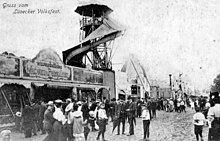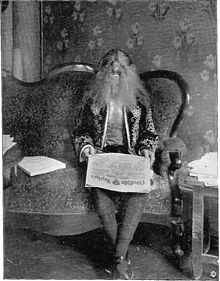Lübeck folk and remembrance festival
The Lübeck People's and Remembrance Festival is Lübeck's annual festival .
Origins
In the course of the events of 1848 , a committee of 15 private people was formed in Lübeck that summer, which announced in the Lübeck advertisements of July 3 that a general target shooting would be held at the Bürgererschützenhof in front of the Holstentor from July 23 to 25. Anyone who paid the fee of 1 Mark Luebsch and 8 Schillings could take part in the shooting competitions . This concept was a radical for Lübeck conditions democratic innovation, because until then the city was Schützenwesen traditionally strictly corporatist organized: The Civil Schützenhof was until then only the Marksmen of the guilds and civil corporations open, held their separate shooting matches here. The event thus had a clear symbolic character. In 1843, a planned folk festival to mark the 700th anniversary of the founding of the city was prevented by the Senate of the Hanseatic city for reasons of the constitutional discussion by means of a Senate decree.
General target shooting took place as planned; the event was given a festive setting by a festive procession of the 1348 participants from the market to the Schützenhof on the opening day. Numerous sales booths were built on the grounds of the Bürgerschützenhof, so that the event took on the character of a folk festival. The connection to the revolutionary events was openly demonstrated through the flagging of the city in black, red and gold , cheers for the imperial administrator John of Austria and patriotic songs. The financial proceeds were donated to the construction of a gunboat for the future imperial fleet , which, however, was never completed.
Development in the 19th century
The general target shooting was planned by the organizers as a one-off event; a repetition was not originally planned. The shooting festival, however, had been well received, and members of the committee received numerous requests to repeat it the following year. Despite the failure of the revolution and efforts to unite Germany, the target shooting also took place in 1849, stripped of overarching political symbolism, but still as a democratic event in which everyone was free to participate. In the next few years the general target shooting became a fixed annual event, which turned more and more into a folk festival and in which the shooting competitions increasingly faded into the background.
In 1852 the festival, which had grown considerably, was relocated from the Bürgererschützenhof , which had become too small, to the Burgfeld . From 1853 onwards, special trains ran , as target shooting increasingly attracted visitors from outside the city after Lübeck's railway connection. The festival soon lost its political character, but became a popular annual event for Lübeck and the wider area, even though it was subject to criticism from the Lutheran state church well into the 1860s , which it was a hotbed of moral neglect and debauchery held.
Target shooting was canceled for the first time in 1866 due to the German War . In 1870, on the other hand, the festival took place despite the declaration of war by France two days earlier, and for the first time since 1848, the public mood gave it a patriotic character. The proceeds were donated to the care of the wounded in the upcoming war.
In 1871 the event was given the current name of the People's and Remembrance Festival , initially as a supplement to the general target shooting . From then on it was emphasized that the festival had its origin in the desire for national unification, which had now taken place. At the same time, the festival committee tried to transform the festival into a dignified solemnity in which the typical folk festival amusements were perceived as inappropriate and were forbidden. However, since this made them less attractive, they were admitted again for the 25th anniversary in 1873. The national aspects of the folk festival were limited to the opening ceremony, the motifs of the parade and the decorations of the fairground.
Towards the end of the 19th century, the two-day Lübeck folk and remembrance festival had become one of the largest folk festivals in northern Germany , bringing together 300 showmen, sales and entertainment businesses.
Development up to the First World War
In the first years of the 20th century the festival continued to grow; In 1912 it was determined that the area of the castle field was no longer sufficient and another venue had to be found. The beginning of the First World War in 1914, which led to the end of the festival, made these considerations irrelevant for the time being.
The pageants and opening ceremonies, which were increasingly aggressive, nationalistic and loyal to the bourgeoisie, made the festival a target, especially for social democrats and trade unions , who also harshly criticized the poor representation of the workers in the program. Until the beginning of the war, nothing changed in the nature of the festival.
The fair took place for the last time in the summer of 1914. During the war years there was absolutely no question of holding a great amusement festival, and in 1919 there were still no initiatives to revive the festival. In addition, a large part of the castle field was still built with hospital barracks that had been built during the war, so that the traditional event area was not available. A small-scale folk festival organized by some showmen in 1920 on an undeveloped part of the castle field received little attention.
Development up to the Second World War
In 1921 a festival committee of showmen was set up who were interested in reviving the Lübeck festival, which was lucrative for them. After the Burgfeld had been freed from the barracks, the folk festival they organized took place in July 1921 on the old scale, now extended to eight days. The audience was great, but the members of the - still existing - old festival committee and the conservative press disparagingly called it a substitute folk festival , which is a purely commercial fair, devoid of content and without any historical or patriotic background .
Despite this criticism, the new folk and remembrance festival enjoyed great popularity, but from 1924 it was in danger. A part of the castle field was to be re-used as a public sports facility, and the city found it unreasonable not to be able to dedicate the area to the common good only for the profit-making interests of the showmen. It was not until 1927 that the city and the showmen came to an agreement: A large open space on Travemünder Allee near Lauerholz became the new permanent venue for the festival. The Volksfestplatz fulfilled this function until 2014.
After the seizure of power by the Nazis in 1933, the festival, which as a home party and so-called learned nationalist tradition was generally regarded by the new rulers with benevolence, various changes. While the extended duration of eight days was retained, the external framework and program design were returned to the forms of the pre-war period, adapted to the new political conditions. Organized by official bodies, there was again a pageant and an elaborate opening ceremony as well as other accompanying events, which were increasingly characterized by National Socialist ideas. The committee of the showmen was only responsible for the construction of the booth town on the fairground. In 1940 the festival was canceled due to the war, but in 1941 and 1942 it took place again, albeit to a lesser extent, only to be finally stopped.
Development in the post-war period
In the summer of 1945 immediately following the end of the war, there was no folk festival, but it was held again in a modest setting and under the name of the amusement market with the approval of the British occupation authorities in 1946 . Because the Volksfestplatz was used to store rubble, the festival took place on the Obertrave on the edge of Lübeck's old town , where the Easter and Christmas markets were also located. To make the journey worthwhile for the showmen, the duration was extended to two weeks. In the following year they returned to the term people and remembrance festival and emphasized the democratic origins of the festival. In 1949 the festival moved to a newly laid out, downtown event location on Possehlstrasse , which offered significantly more space than the street on An der Obertrave.
During the 1950s the festival grew and the number of visitors increased; the supporting program, which was still modest in the early post-war years, became more extensive again. In 1956, the city decided to expand Possehlstrasse, in which the event area had to be reduced considerably, and suggested that the festival committee of the showmen, who organized the festival, move to the festival area, which is now available again. Those affected initially reacted with rejection, as the place appeared to them to be too remote, among other things. However, since there was no alternative, the festival was relocated again and took place on the festival square from 1957 to 2014.
In April 1957, an independent new Lübeck Volksfestkomitee eV was formed , which has since organized and designed the festival instead of the showmen and which is also committed to maintaining tradition. The efforts were already expressed at the folk festival in 1957, which was held again with a pageant and fringe celebrations in a contemporary style and which took place for the first time since the Second World War under its full name Lübeck Folk and Remembrance Festival - General Target Shooting.
The fair today
Since the 1990s, the Lübeck Volksfest has seen a decline in visitor numbers. The reasons are varied and are not assessed uniformly. In addition to competition from other leisure activities, there are other problems, including the organizers' view of the lack of support from the Hanseatic City of Lübeck, which does not mention the festival in the official calendar of events and on the tourism website, has discontinued the bus shuttle service to the festival site that has been offered for years and During the two weeks of the festival, buses no longer have city buses flagged, as was the case in the past, and so the folk festival is pushed out of view. In addition, there are difficulties with the lack of parking spaces in the vicinity of the Volksfestplatz and, in the opinion of the showmen, a lack of identification of the people of Lübeck with their Volksfest, which is so striking nowhere else in Germany.
In 2015 the folk and remembrance festival was relocated from the Volksfestplatz and took place for the first time at the music and congress hall.
Web links
literature
- Gisela Jaacks : The Lübeck People's and Remembrance Festival . Museum of Hamburg History, 1971
Individual evidence
- ↑ Report in the Münchener Allgemeine Zeitung No. 133 of May 13, 1843 (digitized version) , with the same wording in several German newspapers.
- ↑ Premiere for the Volksfest at the MuK , Lübecker Nachrichten online, June 6, 2015




